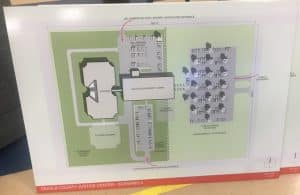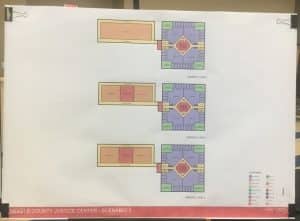March 21, 2024
By: Dwayne Page
Could a new jail/judicial center be constructed on the site where the existing jail is located?
(View Video of Town Hall Meeting Below which featured Stephanie Harding, Detention Facility Manager at the Tennessee Corrections Institute (TCI); Jim Hart, Jail Consultant and Field Manager of the County Technical Assistance Service (CTAS); John Eisenlau of Treanor HLArchitects )
During a monthly jail committee meeting following a public town hall forum Monday night, John Eisenlau of Treanor HL Architects said it is conceivable to build up to a four-story facility adjacent to the east side of the jail annex on property the county already owns but that it would need more than one floor to accommodate housing for up to 225 inmates and as many as four courtrooms. But while the building could be made to fit on the existing site, there are factors that could make it impractical. For example, Eisenlau said the property does not have sufficient parking space for a new facility of this type. Further, studies have not yet been done to determine if the soils there can support a multi-story building or if the site would meet city codes pertaining to property setback requirements, etc. A study might also be needed to determine if more jail employees would be required to properly staff a facility with more than one floor of inmate housing. Opponents of this option claim that building on the existing site would not provide room for future expansion and that it might ultimately be just as costly as building on another site.
The jail committee made no decision during its meeting Monday night on what the county’s next step should be in this process.
During a meeting in February, Eisenlau of Treanor Architects and Rick Bruining of Bell Construction unveiled options for a 150, 190, and 225 bed facility as requested by the jail committee in January. Based on the three options presented by Bell, the projected cost of judicial center construction would range from $57,317,500 for a 150-bed jail (with no shell space for future expansion) to $70,317,500 for a 225-bed facility. These numbers did not include whatever the cost may be to purchase property for the project, if necessary.
After learning how costly the project as presented would be, several county commissioners at the February meeting suggested that the architect and contractor take another look at the existing jail location and possibly come up with a phased renovation/expansion plan for that site, something the public might more likely embrace.
During Monday night’s meeting, Eisenlau initially laid out for the jail committee, as he had done in February, the best two options (single and two-story) for construction on property other than the existing jail location. These scenarios include the jail and inmate housing facilities, a courtroom complex, sheriff’s administration building, and parking areas altogether consisting of 100,000 square feet on 13.5 acres. In each scenario, Eisenlau said the jail would house prisoners on the first floor with a second story mezzanine to house more inmates. In the second option, the entire complex would be a two-story structure.
“We were tasked with telling you what size facility you would need for as many as 225 beds,” said Eisenlau. “We took that as a starting point with 225 beds and four courts, and if you build courts they should be built in pairs as a design rule, because often they are serviced by holding areas. As presented last month, this building we designed is roughly 100,000 square feet for 225 beds and in my estimation, it would need to sit on approximately 14 acres. The reason for that is because you have a considerable amount of public parking, jail staff parking, and courts parking, all of which need to be separated. And the public would never be inside the fence line. Anybody that works for the court or the jail typically would park inside the fence line so their cars couldn’t be damaged or stolen, etc. Jails also require what’s called a fire lane which goes around your housing unit and its required by the municipalities to put a fire out. It has to be a certain distance from the building. There are a lot of these types of nuances to laying out a jail that are very critical to building a modern detention facility and courts combined,” Eisenlau explained.
“Our recommendation here (initial scenario) was to build the jail itself which would be attached to the housing with the courts and the sheriff’s administration having separate buildings (in the complex). We typically recommend this (scenario) because you don’t necessarily have to build it all at one time. You could master plan this to build a jail first and then build the courts and sheriff’s admin later. That’s up to you. This would be the ideal scenario,” said Eisenlau.
However, according to Eisenlau, the second scenario (two story structure throughout) was developed as possibly a less costly option.
“The way you make that (first option) cheaper is put all that stuff (jail, sheriff’s department, courtrooms) in one big box (two story) which is a lot cheaper typically than spreading the building out,” he said.
After going back to the drawing board since the February meeting, Eisenlau said a third scenario option has been developed for the existing site where the jail is located on property the county already owns.
“If you build an entirely new jail on the (existing) property, what would it look like?. This new jail is roughly 71,000 square feet. If you choose to do so, you could build a new structure on this property (east side of jail annex) either one story, two stories, three stories, or four stories tall,” explained Eisenlau. “How the guts of the building would work we would have to consult with the sheriff on that but numerically if you take 225 inmates and multiply them by 350 gross square feet per detainee which is the industry standard and you stack that number on four floors believe it or not, it fits (on the existing site) and the sheriff can continue to operate right where he is although it would be extremely disruptive to build next to him but you could build this building next to the sheriff. I would then recommend that you tear down the jail (original jail and annex) and you build a new court building. The first floor could be for all of your court clerk functions and then have your courts stacked on two floors above it. And what’s really nice about this particular option is that you can quickly get from the housing units to the courts. Then you could move out of your courts building (courthouse) and lease or use that for other purposes such as administrative services or historic events, etc. There are challenges with this idea (scenario) because you need a lot of parking, and we did not solve that (with this option). There is limited parking, and these deficiencies could be problematic on this (existing) site, and we would have to spend a lot of time talking to the sheriff’s department about how this housing is specifically organized in the building so that we don’t increase his staffing requirements in supervising inmates” said Eisenlau.
“The interesting take away is that it is conceivable that you could build on your current location with the building itself on one level and the housing units with mezzanines above it. This would basically be a three-story building (which could be converted to two levels to require less staff) on top of the first level which I will call the basement but right now its technically a four-story building which is in compliance with the building codes that allow you to go up to 75 feet from the fire department connection to the top accessible level of the building. As long as we stayed 75 feet, you could stack the building vertically. I was particularly surprised that the court rooms would actually fit on this site, but they do. That is something we had not initially contemplated. The first thing you need to do is get some soil samples to see if we can stack the building that high and get a good survey. After that, I could tell you definitively whether it (this scenario) would work but I can say that while more study is needed, it is feasible,” said Eisenlau.
Prior to the jail committee meeting, several residents showed up to express their opinions and ask questions during the town hall meeting including Steven Cantrell who is not sold on the judicial center option being considered by the county.
“We need a jail and the Tennessee Corrections Institute has told us what we need at a minimum. And that our jail operation can maintain state certification as long as the county continues to make measurable progress under a master plan of action. A justice center is not required, but it is an additional tax burden that this committee and mayor have proposed putting on the taxpayers of DeKalb County,” said Cantrell.
“We need to focus on what TCI has recommended as the minimum to meet standards due to the other challenges facing the county and its taxpayers”.
“We need a jail, not a justice center,” Cantrell continued.
“As for concerns about the courts and security of the courthouse, there is an easy solution which would be less of an impact on the taxpayers of DeKalb County. Turn the courthouse into the county courthouse it was dedicated to be in 1970 and as engraved on the outside of the building and move all non-judicial county offices to the county complex unless there is a legal reason they are required to be in the courthouse: County Executive, Veterans Office, Election Commission, THP Office”.
“Secure the courthouse just like other courthouses are done in many parts of Tennessee with one security entrance and one secure exit. All other doors would be alarmed as fire doors”.
“Understanding that we already have two magnetometers on the third floor we could move these to a single entrance. And since all offices remaining in the courthouse would be judicial in nature, in theory this would reduce the number of visitors and provide security for the courts?
“Obviously, we would need to evaluate the options here”.
“However, as such this would not require a judicial center and we could get back to focusing on the real priority here which is a new jail to meet this county’s requirements and be in line with TCI recommendations. And it would respect the county taxpayers’ hard-earned dollars in the process,” said Cantrell.
The jail committee will meet again in April.






